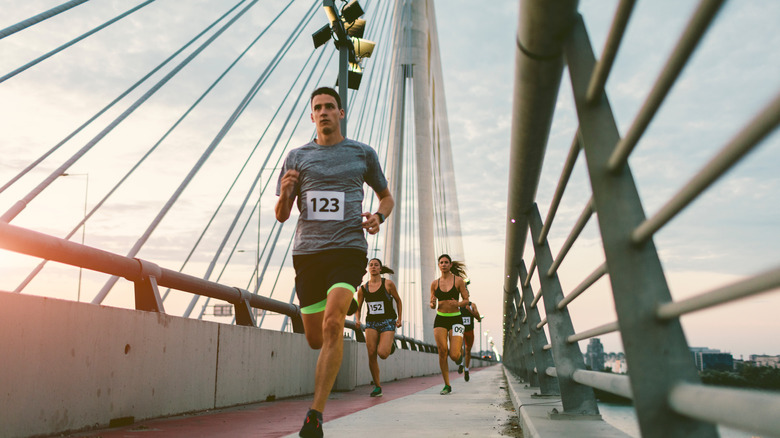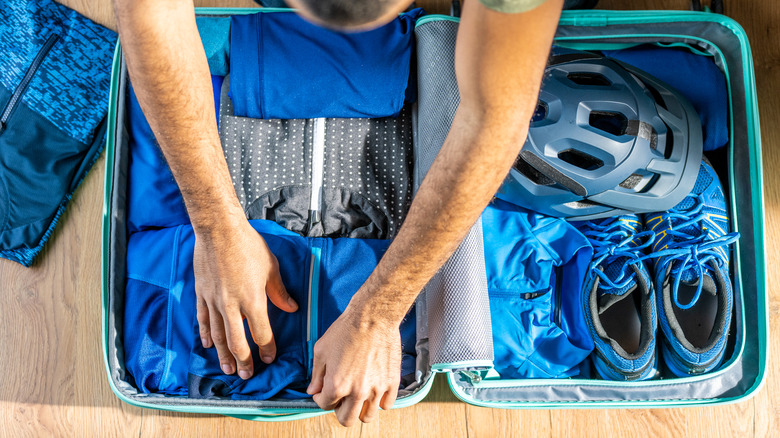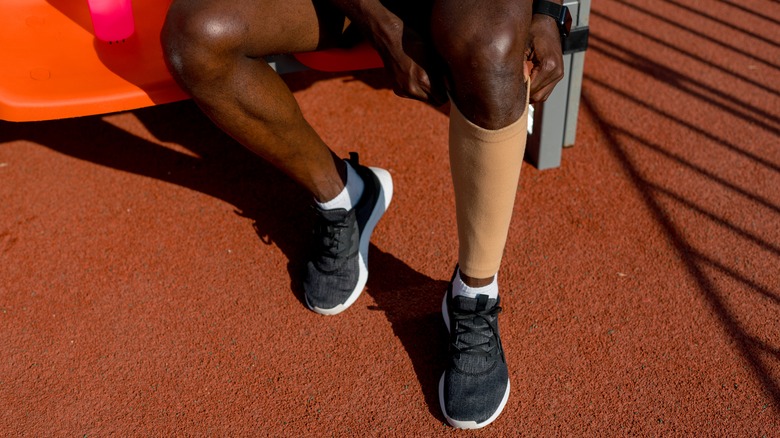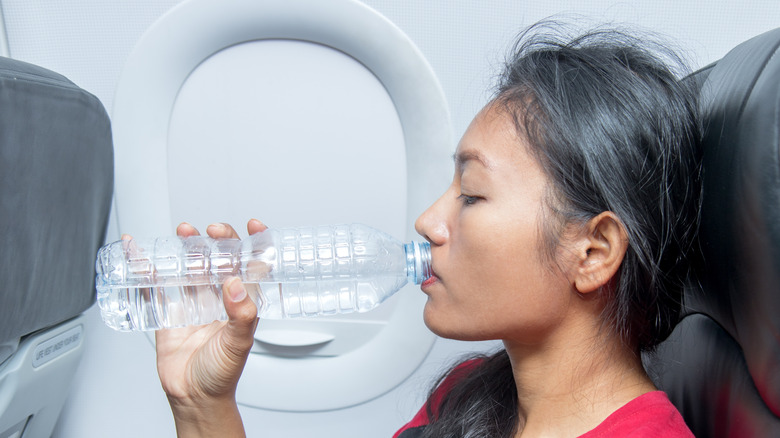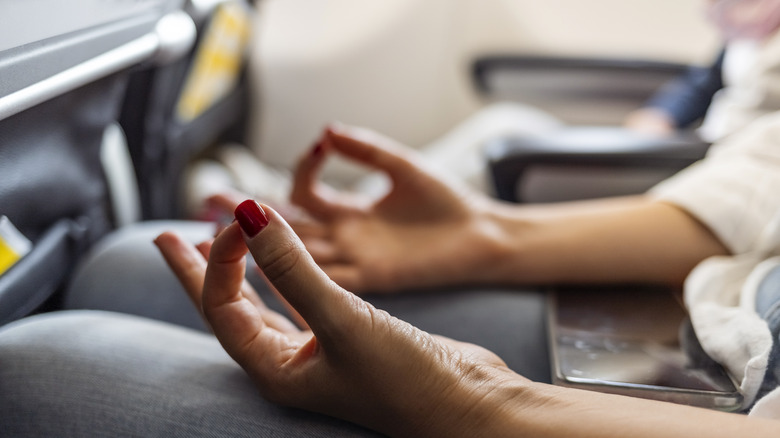Traveling For A Sports Event? Tips To Keep You Competition-Ready While Flying
We may receive a commission on purchases made from links.
People travel for many reasons, like work, seeing family, vacationing, and spending time with friends. Some of us also journey for sporting events. It's one thing if you're flying to Europe to watch a soccer game, but what if you're competing?
Whether you're on a sports team, traveling to run in an out-of-town marathon, participating in a cross-country bike race, or a dance competition, there are many things to consider to ensure you're competing at your best. Issues like jet lag, dehydration, and plane swelling can affect your performance. Plus, traveling to different places and eating unfamiliar foods can wreak havoc on your stomach.
You can take many steps to prevent travel from downgrading your athletic abilities, from knowing what to pack and handling the dry air on a plane to moving during a long flight. We have all the tips to ensure you're ready to compete and in good enough shape to win.
Packing and planning to prevent jet lag
Jet lag is one of the biggest issues people have when traveling, especially for sports. It robs us of energy and causes disorientation. Travel a few days before an event to adjust to a time difference. If you can't, try to get there the day before, early enough to stay up all day until your normal bedtime or a little earlier. Check your hotel to see if the rooms have blackout curtains (If not, pack a sleep mask and earplugs), and open them fully when you wake up the next day. Exposure to light can help get you moving. Keep your training light a day or two before the event, but don't skip it if you can. The more you stick to a normal schedule, the better.
Lay off the alcohol if possible, as it can disrupt sleep patterns and cause dehydration. Powdered or tablet versions of your typical sports drinks are great to pack, along with any energy bars and-or snacks you usually eat. That way, you can skip the plane food and salty minibar pretzels. If you're used to caffeine but don't want to use the restroom all morning (coffee can encourage bowel movements), energy shots are easy to pack in a carry-on. If you can't sleep well without your pillow from home, just bring it. And don't forget some large resealable bags for wet, sweaty clothing and sneakers.
What to do before the flight
A few other planning bits can save you a lot of heartbreak in the long run. In addition to asking the hotel about blackout curtains, reach out and see if there is a safe place to train nearby, like a gym or a walkable neighborhood for running around the block. Will there be a tub if you need an ice bath for an injury? And an ice machine, of course.
Ask if the neighborhood is safe if you have to leave before dawn for an early marathon start, and if someone will be at the front desk. Also, check in about the menu and food availability in the surrounding area, especially if you arrive late in the evening. That way, you can prepare to eat healthy, even if it means packing meals.
If your sport involves legs and feet, you might be worried about swelling on the plane. Compression socks are one idea to help combat that. They don't all look like Grandpa's socks. Many of them are brightly colored with fun patterns, and many athletes use them to avoid swelling and a feeling of exhaustion in the legs.
Dealing with dehydration
Dehydration can harm your physical and mental health when you're competing. Skip the alcoholic drinks on the plane and opt for plain water or the powdered sports drink you packed. Alcohol can cause dehydration, as we mentioned, and can make sleep more difficult.
Dehydration can also mess up your digestion, so follow the advice of Amanda Shannon Verrengia, a personal trainer and USATF/RRCA run coach, who told Runner's World that she makes sure to drink one glass of water every hour while traveling. Pack a collapsible, reusable water bottle to avoid spending much money at the airport. Choosing one with measurements on it is a great idea so you don't skip the prescribed amount of liquid. If you're getting in the day before your event, stay extra hydrated that day to make up for the plane.
Remember those energy bars you packed? Eat those instead of the salty and unhealthy snacks served on a plane, which can exacerbate dehydration, swelling, and bloating. Skip the carbonated beverages for the same reason.
Preventing stomach issues
Let's discuss the delicate issue of stomach problems. Travel can sometimes upset your stomach, and difficult exercises like running can toy with your digestion while competing. Plus, nerves aren't great for the tummy either, and you probably have those. As we said, staying hydrated helps, but skip chewing gum as well, as it can cause bloating, especially those with artificial sweeteners. You should also avoid high-fat foods when you land, so you want to know what's available where you're staying.
Another tried-and-true method for keeping your stomach happy is eating higher-fiber foods the day before you fly, which can curb bloating. Although, skip those the night before your event to avoid bathroom trips while in competition mode. If you end up with a roiling gut, peppermint tea can help; many hotels and coffee shops have that available. Try to relax as much as possible beforehand because the stress hormone cortisol can urge you to use the restroom. You can't avoid all stress, but anything you can do to stay calm can help.
What to do on your flight and after
Sitting for long periods can be rough when you're about to compete in an athletic event. If you have a long flight, try to reach your destination at least 24 hours before. Whether that can be managed depends on your schedule and finances, but other things can help keep your legs in good shape.
Many airlines have short plane yoga sessions you can do in your seat on the in-flight entertainment system that can help keep your stress level down. If you can, get up and walk the aisle back and forth every 30 minutes to get the blood moving, as Jamey Harris, head coach for Cross Country and Track & Field at UC Santa Cruz, told Runner's World. We recommend an aisle seat so as not to inconvenience your seatmates.
To keep your feet in good shape, you can draw the alphabet once an hour with your toes on the floor and flex and point your feet. Another thing you can do is bring an exercise band that stretches. Loop it around your foot and do gentle stretches down with your toes, which shouldn't bother your neighbors. When you get to your hotel, raise your feet above your heart for a bit to help dissipate any swelling, and maybe do a quick jog, hike, or gym session to get the blood moving again. You've got this!
